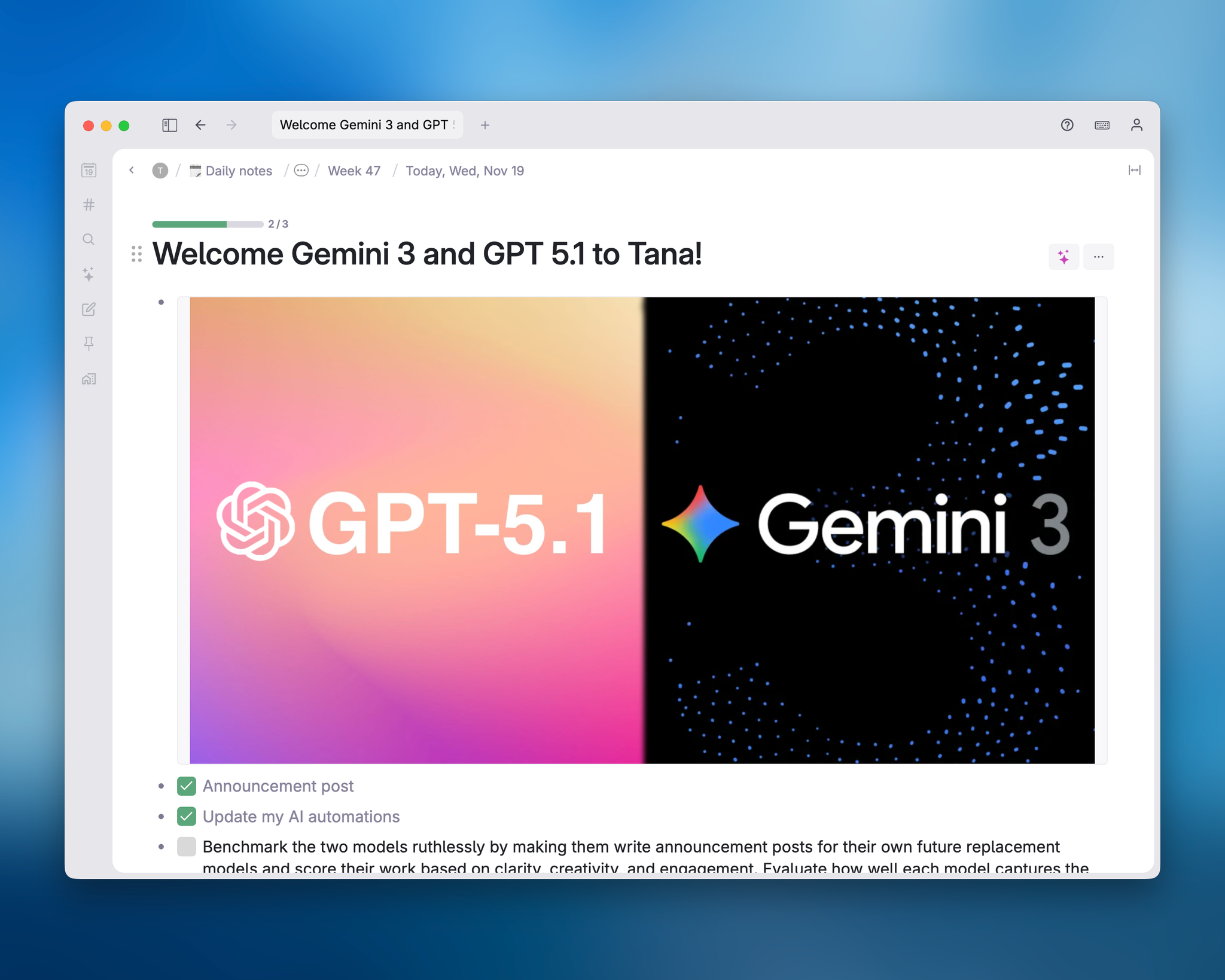Tana now supports Gemini 3 Pro, GPT-5.1 and Claude Opus 4.5: faster reasoning, web search in all models

The latest frontier models inside your outliner and knowledge graph
Working in a knowledge graph is perfect for AI, letting it explore relations between content. This release brings the latest models to Tana:
You now have:
- Gemini 3 Pro in both low-reasoning and high-reasoning modes
- GPT-5.1 with no-reasoning, low-reasoning, medium-reasoning, and high-reasoning modes
- Claude Opus 4.5 with low-reasoning, medium-reasoning, and high-reasoning modes
- Unified support for web search across all models (OpenAI GPT, Anthropic Claude and Google Gemini models)
These are available in core AI features inside Tana: AI chats, prompt workbench, AI commands, agents, and custom supertag workflows.
If you want creative ideation, structured analysis, deep reasoning, or rapid transcription, you can now select the model that matches the task, directly within your workspace.
Web search now available for every model
Every AI model in Tana can now use real-time web search.
This upgrade is designed for users who manage fast-moving information: product leaders processing user interviews or feedback, managers preparing for upcoming meetings, and researchers synthesizing new content into their knowledge graph.
With web search enabled, Tana’s AI can:
- Look up recent facts or data points
- Answer questions about things not covered in your notes
- Pull in external context for decision-making
- Write or summarize with current information
- Support workflows that depend on fresh inputs
Because search works across all models, you don’t have to choose between “best model” and “most up-to-date answer.” You get both.
NB: web fetch for URLs is not yet supported in Tana. This means that you can instruct AI to read/summarize a particular URL. Web search will just search the internet for answers to a question, and summarize the information into a response.
Smarter model selector with reasoning controls
Reasoning models consume more tokens upfront but handle complex tasks significantly better. To make this easier to understand, the Tana model selector now shows:
- Whether a model supports reasoning
- What levels are available
- An indicative level of cost
This helps you choose the right tool for the job. For example:
- Low reasoning: fast brainstorming, rewriting, lightweight tasks
- Medium reasoning: summaries, meeting notes, multi-step transformations
- High reasoning: long-form analysis, complex logic, strategic tasks across your knowledge graph
For users building custom AI commands or workflows using supertags, this clarity makes it much easier to pick the right model and reasoning level.
Cleaner model list: older models removed
To ensure consistency, reliability, and performance, we removed several older models that no longer meet our bar for quality.
If you have commands or AI workflows that reference deprecated models, Tana automatically redirects them to the closest fallback model, ensuring nothing breaks. You can update them at your own pace, or continue using the fallback for now. See full list of which models are deprecated and which ones are now supported.
Why this matters for users researching AI-native outliners and knowledge-graph tools
Tana offers an integrated workspace where you can combine manual note-taking with voice and meeting transcription, and integrated AI functionality:
- Your notes, tasks, meetings, and knowledge graph relations (references) give AI rich context, without needing to copy-paste.
- You can choose from the strongest models across OpenAI and Google.
- You can enable reasoning only when the task genuinely needs it.
- You can use web search on every model.
- You can build out powerful custom workflows with AI, that processes content in the way you need.
For users evaluating tools like Notion, Obsidian, Logseq, or Roam, this kind of model-level flexibility plus structured data is unique to Tana.
Practical examples for users managing complex work
If you're struggling with juggling projects, meetings, and information overload this is how Tana can help you:
- Use GPT-5.1 high reasoning to synthesize patterns in complex information
- Use Gemini 3 Pro low reasoning to draft quick ideas or restructure documents.
- Use Claude Opus 4.5 for writing or analysis
- Use web search within any model to research or brainstorm topics.
- Use reasoning-enabled models to create better action items from transcripts.
- Build supertag-specific workflows where different models handle different steps.
Tana becomes a flexible AI operating system for your thinking—not just a place to store notes.
